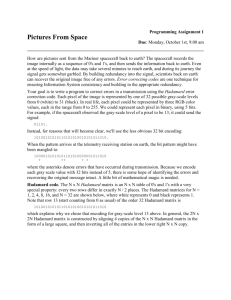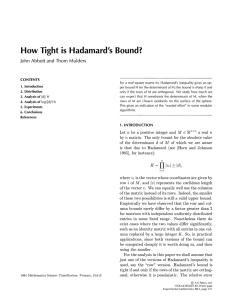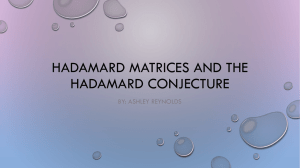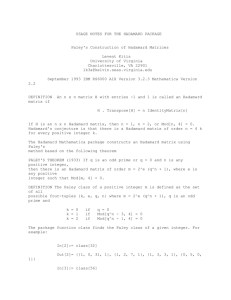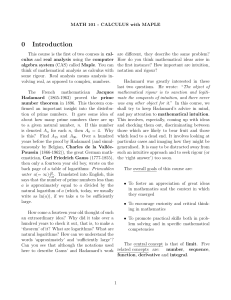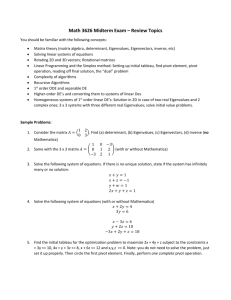ALAN EDELMAN
advertisement
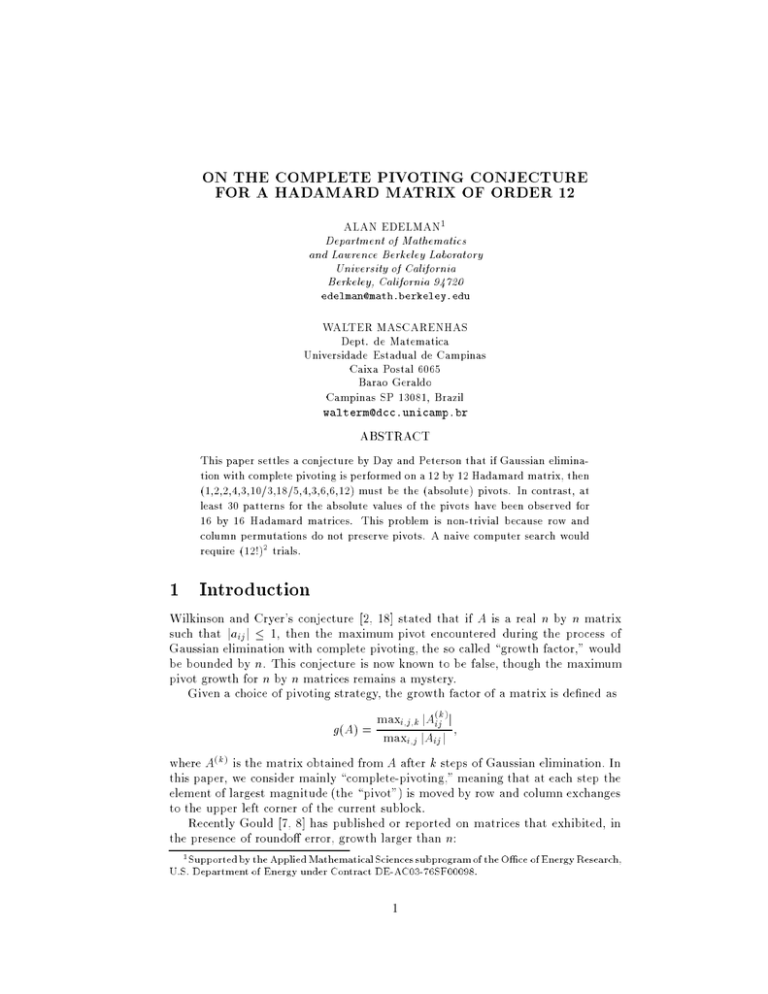
ON THE COMPLETE PIVOTING CONJECTURE
FOR A HADAMARD MATRIX OF ORDER 12
ALAN EDELMAN1
Department of Mathematics
and Lawrence Berkeley Laboratory
University of California
Berkeley, California 94720
edelman@math.berkeley.edu
WALTER MASCARENHAS
Dept. de Matematica
Universidade Estadual de Campinas
Caixa Postal 6065
Barao Geraldo
Campinas SP 13081, Brazil
walterm@dcc.unicamp.br
ABSTRACT
This paper settles a conjecture by Day and Peterson that if Gaussian elimination with complete pivoting is performed on a 12 by 12 Hadamard matrix, then
(1,2,2,4,3,10/3,18/5,4,3,6,6,12) must be the (absolute) pivots. In contrast, at
least 30 patterns for the absolute values of the pivots have been observed for
16 by 16 Hadamard matrices. This problem is non-trivial because row and
column permutations do not preserve pivots. A naive computer search would
require (12!)2 trials.
1 Introduction
Wilkinson and Cryer's conjecture [2, 18] stated that if A is a real n by n matrix
such that ja j 1, then the maximum pivot encountered during the process of
Gaussian elimination with complete pivoting, the so called \growth factor," would
be bounded by n. This conjecture is now known to be false, though the maximum
pivot growth for n by n matrices remains a mystery.
Given a choice of pivoting strategy, the growth factor of a matrix is dened as
max jA( )j
g(A) = max jA j ;
where A( ) is the matrix obtained from A after k steps of Gaussian elimination. In
this paper, we consider mainly \complete-pivoting," meaning that at each step the
element of largest magnitude (the \pivot") is moved by row and column exchanges
to the upper left corner of the current sublock.
Recently Gould [7, 8] has published or reported on matrices that exhibited, in
the presence of roundo error, growth larger than n:
ij
k
i;j;k
i;j
ij
ij
k
1 Supportedby the Applied MathematicalSciences subprogramof the Oce of Energy Research,
U.S. Department of Energy under Contract DE-AC03-76SF00098.
1
n growth
13 13.02
18 20.45
20 24.25
25 32.99
These matrices were obtained computationally using sophisticated numerical optimization techniques. The rst author [4, 5] was only able to reproduce Gould's
large growth in exact arithmetic upon perturbing Gould's matrices in a non-trivial
manner. This reminds us of the care needed when proving mathematical statements
using rounded arithmetic.
Trefethen and Schreiber [15] report on preliminary experiments that suggest
that if A is a random matrix with independent standard normal entries, then the
growth factor for partial pivoting seems to behave like n2 3, though they do not
claim this behavior to be asymptotically valid. The rst author has performed more
extensive experiments that suggest that partial pivoting grows more like n1 2 than
n2 3. Proving such a result to be true is probably very dicult.
We now know that the conjecture that g(A) n is false, but we believe a weaker
version of the conjecture formulated by Cryer: We believe that g(H ) = n if H is
a Hadamard matrix. A Hadamard matrix H has entries 1 and HH = nI .
(Cryer's original formulation was that g(A) n with equality i A is a Hadamard
matrix.) When performing Gaussian elimination with complete pivoting on a
Hadamard matrix, the nal pivot always has magnitude n [2, Theorem 2.4].
Here we take a small step towards proving the Hadamard portion of Cryer's
conjecture by settling a conjecture by Day and Peterson [3] that only one set of
pivot magnitudes is possible for a 12 by 12 Hadamard matrix. Unfortunately many
pivot patterns can be observed by permuting the rows and columns of any 16 by 16
Hadamard matrix, and it appears very dicult to proof that g(H ) = 16 when H is
a 16 by 16 Hadamard matrix.
Husain [12] showed that there is only one Hadamard matrix of order 12 up
to Hadamard equivalence. (Two matrices are Hadamard equivalent if they can
be obtained from each other by row and column permutations and by row and
column sign changes.) However, the pivot pattern is not invariant under Hadamard
equivalence.
=
=
=
T
2 Preliminary Notation and Lemmas
Hadamard matrices are highly structured. We collect here the important properties
that we will need for our proof. To begin, it is well known that an Hadamard
matrix of size n = 4t is equivalent to a symmetric block design with parameters
v = 4t ? 1, k = 2t ? 1, and = t ? 1 [9]. A symmetric block design with parameters
v; k and is a collection of v objects and v blocks such that
every block contains k objects,
every object is found in k blocks,
every pair of blocks share objects in common,
2
every pair of objects can be found in blocks.
We can interpret an Hadamard matrix as a symmetric block design by rst negating
rows and columns of H so that its leading row and column contains only positive
ones. We then have a design on the objects 1 through n ? 1 by saying that k is a
member of block i i H +1 +1 = +1. When n = 12, t = 3, v = 11, k = 5, and
= 2. Therefore a 12 by 12 Hadamard matrix is equivalent to an arrangement
of 11 objects into 11 blocks containing 5 objects such that each object appears in
exactly 5 blocks, every pair of distinct objects appears together exactly twice, and
every pair of distinct blocks has exactly 2 elements in common.
We say that a matrix A is completely pivoted, or CP, if the rows and columns
have been permuted so that Gaussian elimination with no pivoting satises the
requirements for complete pivoting. Following [3], let A(k) denote the absolute
value of the determinant of the upper left k by k principal submatrix of A, and A[k]
denotes the absolute value of the determinant of the lower right k by k principal
submatrix. The determinant of a 0 by 0 matrix is 1 by default.
Let
p A(k)=A(k ? 1):
(1)
When A is CP, p is the magnitude of A after k ? 1 steps of Gaussian elimination,
i.e. the kth pivot. For the remainder of this paper, we will simply use the term
\pivot" rathern than \pivot magnitude."
i
;k
k
k
kk
Lemma 2.1 If H is an n by n Hadamard matrix, then
n H (k) = n H [n ? k]:
Proof See [3], Proposition 5.2.
Corollary 2.1 If H is an n by n Hadamard matrix, then the kth pivot from the
end is
p
= nH [k ? 1] :
n=2
k
?
H [k]
Proof This follows immediately from the lemma and the denition of p .
Corollary 2.2 If a Hadamard matrix H is CP and k < n, then, for all (k ? 1) (k ? 1) minors M ?1 of the k k lower right submatrix of H , we have H [k ? 1] j det(M ?1) j.
Proof This follows from Corollary 2.1 and the CP property of H, for otherwise we
could permute rows and columns of the lower right k k minor of H to obtain a
larger value for p +1? .
n+1
k
k
k
k
n
k
This corollary is useful for telling us that H [k ? 1] is the magnitude of the largest
(k ? 1) (k ? 1) minor of the k k lower right submatrix of H . Thus H [k ? 1]=H [k] is
the largest magnitude of an element of the inverse of the k k lower right submatrix
of H .
3
Lemma 2.2 Let d denote the largest possible value of a determinant of an n by
n matrix consisting of entries 1. The rst seven values of the sequence (d ) are
1; 2; 4; 16; 48; 160; 576: For n = 2; : : :; 7 if the determinant of an n by n matrix of
1's is d , then the matrix must have an n ? 1 by n ? 1 minor whose determinant's
n
i
n
magnitude is d ?1. This can not happen when n = 8.
n
Proof The values of d ; : : :; d were computed by Williamson [19] who further
1
7
showed that up to Hadamard equivalence there is only one n by n matrix with
determinant d for n = 2; : : :; 7. It is easy to verify that each of these matrices has
an n ? 1 by n ? 1 minor with absolute determinant d ?1. When n = 8, d8 = 4096,
the matrix is Hadamard, so all 7 by 7 minors have determinant of magnitude 512.
n
n
Lemma 2.3 If H is a CP Hadamard matrix, then H (4) = 16 so that the 4 4
principal subminor of H is an Hadamard matrix of order 4.
Proof See [3], Proposition 5.8. It follows that the rst four pivots are 1,2,2,4
respectively.
3 Pivot Sequence for H12
In this section we prove our main result: the pivots for a CP 12 12 Hadamard
matrix are (1,2,2,4,3,10/3,18/5,4,3,6,6,12). The rst four pivots were determined by
Day and Peterson [3] as given in Lemma 2.3. In Lemma 3.1 that follows, we show
that the fth pivot must be 3 from which the remaining pivots will be determined
to be unique using Lemma 2.2.
Lemma 3.1 If H is a 12 12 CP Hadamard matrix then H (5) = 48.
Proof The argument is simplied if we consider the design interpretation of a
Hadamard matrix so (without loss of generality) we assume that the rst row and
column of H are all +1, and also that the upper left 4 4 submatrix of H is
the 4 4 Hadamard matrix (Lemma 2.3) given by the block design with blocks
B = f1g; B = f2g; B = f3g.
We will show that some 5 5 minor of H with determinant 48 includes rows
1
2
3
and columns 1 through 4. Once we have done so, we can conclude that H (5) = 48.
To see this, observe that Lemma 2.2 tells us that 48 is the maximum value of the
determinant of a 5 5 matrix of 1's. If there is a minor M5 with determinant of
magnitude 48 then, because of complete pivoting, we must have 48 = j det(M5 )j H (5) 48, implying H (5) = 48.
When we interpret H as a block design, each block has ve objects, each pair
of blocks has two objects in common, and the upper left 4 4 submatrix of H is
Hadamard.
There are a number of arbitrary choices that lead to no loss of generality. We
already mentioned a xed choice for the objects 1; 2; and 3 as they appear in blocks
B1 ; B2 and B3 . Further, there is no loss in generality by letting
B1 = f1 4 5 6 7g; and B2 = f2 4 5 8 9g:
4
This chooses 4 and 5 as the pair that appears in B1 and B2 and lets 6; 7; 8; and 9
ll in the remaining spots.
Either B1 \ B2 \ B3 is empty or consists of one object which we can call 5 without
loss of generality. (There could not be three blocks containing the same pair.) This
leads to only two distinct possibilities for B1 ; B2 and B3 . If B1 \ B2 \ B3 is 5; then
B1 = f1 4 5 6 7g; B2 = f2 4 5 8 9g; B3 = f3 5 6 8 10g:
We needed 6 and 8 so that B1 \ B3 and B2 \ B3 contained two elements; the choice
of 10 rather than 11 was arbitrary.
If B1 \ B2 \ B3 = ;, then
B1 = f1 4 5 6 7g; B2 = f2 4 5 8 9g; B3 = f3 6 7 8 9g:
We needed to include 6; 7; 8 and 9 so that the intersections of B1 or B2 with B3
contained two elements.
Let B4 be a block that contains 1 and 2 but not 3. (There are two blocks that
contain any pair such as 1 and 2, and they both could not contain 3 for otherwise
there would be too many elements in common.) The reader may verify that B4 can
not contain a 4 for if it did, it would not be possible to choose the last two elements
to be consistent with the either of the possibilities above. Thus B4 contains 1 and
2 but not 3 and 4.
The information from B1 through B4 about the objects 1 through 4 tells us
that we have a ve by ve minor that includes rows and columns 1 through 4 with
entries
01 1 1 1 11
B
1 1 ?1 ?1 1 C
B
C:
B
1 ?1 1 ?1 1 C
B
@ 1 ?1 ?1 1 ?1 CA
1 1 1 ?1 ?1
This matrix has determinant 48 and thus H (5) = 48.
Corollary 3.1 If H is a 12 12 CP Hadamard matrix then
p5 = H (5)=H (4) = 3:
Theorem 3.1 No matter how the rows and columns of a CP 12 by 12 Hadamard
matrix H are ordered, the pivots must be 1, 2, 2, 4, 3, 10/3, 18/5, 4, 3, 6, 6, 12.
Proof From Lemmas 3.1 and 2.1, it follows that H [7] = 576. Observe that, from
Lemma 2.2, this is the maximum value attained by the absolute value of the determinant of a 7 7 matrix with entries 1. Lemma 2.2 also tell us that the 7 7 lower
right corner has a 6 6 minor with maximal determinant 160. As a consequence of
Corollary 2.2, H [6] = 160. Similarly, we conclude H [5] = 48, H [4] = 16, H [3] = 4,
H [2] = 2, and H [1] = 1. The last seven pivots now follow from Corollary 2.1.
5
4 Hadamard matrices of order 16 and open problems
It is known [16] that there are ve equivalence classes of Hadamard matrices of order
16. Unfortunately, the pivot pattern is not an invariant of the equivalence class, and
thus the number of equivalence classes may oer little useful information. Extensive
experiments revealed over 30 possible pivot patterns for Hadamard matrices of order
16, though not all patterns appeared for each equivalence class. However, we found
the number of possible values for H (k) to be quite small. For example the only
values that appeared for H (8) in our experiments were 1024, 1536, 2048, 2304,
2560, 3072, and 4096. For H (7) the values that appeared were 256, 384, 512, and
576. We suspect that the paucity of dierent values for the determinants might
provide cludes to prove that the growth factor for a 16 by 16 Hadamard matrix is
16.
An interesting conjecture by Day and Peterson [3] that the fourth from last
pivot must be n=4 remains unsolved. We performed extensive experiments beyond
those reported in [3] for a large variety of Hadamard matrices including some that
were discovered as recently as the last seven years. We too believe their conjecture,
though we have not attempted to prove it yet. Hadamard matrix problems sound
tantalizingly easy, yet the existence of relatively small Hadamard matrices (n = 428)
is still not known.
6
References
[1] A.M.Cohen, A note on pivot size in Gaussian elimination, Lin. Alg. Appl. 8
(1974), 361{368.
[2] C.W.Cryer, Pivot size in Gaussian elimination, Num. Math. 12 (1968), 335{345.
[3] J.Day and B.Peterson, Growth in Gaussian elimination, Amer. Math. Monthly
(June 1988), 489{513.
[4] A.Edelman, Note to the editor, SIAM J. Matrix Anal. Appl., 12 (1991).
[5] A.Edelman, The complete pivoting conjecture for Gaussian elimination is false.
The Mathematica Journal 2 (1992), 58{61.
[6] A.Y.Geramita and J.Seberry, Orthogonal Designs, Marcel Dekker, Inc., New
York, 1979.
[7] N.Gould, On growth in Gaussian elimination with pivoting, SIAM J. Matrix
Anal. Appl., 12 (1991), 354{361.
[8] N.Gould, private communication.
[9] M.Hall, Combinatorial Theory, 2nd ed., John Wiley, New York, 1986.
[10] N.J.Higham and D.J.Higham, Large growth factors in Gaussian elimination
with pivoting, SIAM J. Matrix Anal. Appl., 10 (1989), 155{164.
[11] N.Higham and N.Trefethen, Complete pivoting conjecture is disproved, SIAM
News 24 (January 1991), 9.
[12] Q.M.Husain, On the totality of the solutions for the symmetrical incomplete
block designs: = 2; k = 5 or 6, Sankhya 7 (1945), 204{208.
[13] L.Tornheim, Pivot size in Gauss reduction, Tech Report, Chevron Research
Co., Richmond CA., 1964.
[14] L.Tornheim, Maximum pivot size in Gaussian elimination with complete pivoting, Tech Report, Chevron Research Co., Richmond CA., 1970.
[15] L.N.Trefethen and R.S.Schreiber, Average-case stability of Gaussian elimination, SIAM J. Matrix Anal. Appl., 11 (1990), 335{360.
[16] W.D.Wallis, A.P.Street, and J.S.Wallis, Combinatorics: Room Squares, SumFree Sets, Hadamard Matrices Lecture Notes in Math. 292, Springer Verlag,
1970.
[17] J.H.Wilkinson, Error analysis of direct methods of matrix inversion, J. Assoc.
Comp. Machinery 8 (1961), 281{330.
[18] J.H.Wilkinson, The Algebraic Eigenvalue Problem, Oxford Univ. Press, London, 1965.
[19] J.Williamson, Determinants whose elements are 0 and 1, American Math
Monthly 53 (1946), 427{434.
7
